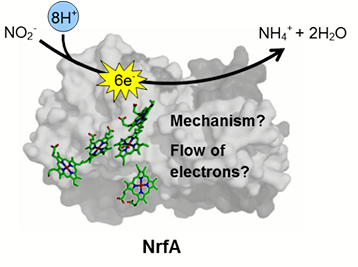Research: Project 1
Cytochrome c nitrite reductase: Converting an environmental contaminant into fertilizer

All organisms require fixed nitrogen for survival. One important and poorly understood enzyme in the global nitrogen (N) cycle is the pentaheme cytochrome c nitrite reductase, known as NrfA. It catalyzes the remarkable six-electron and eight-proton reduction of nitrite (NO2–) to ammonium (NH4+), the key step in anaerobic nitrate (NO3–) respiration during dissimilatory nitrate reduction to ammonium (DNRA). Once thought to be relatively uncommon, the DNRA pathway is now known to be widespread in bacterial communities and a significant contributor to the global N cycle. Despite the availability of a number of NrfA crystal structures, the detailed mechanism by which the enzyme catalyzes the reduction of NO2– to NH4+ remains largely unclear.
The goals of this project are to ascertain the enzymatic mechanism of NrfA, elucidate the strategy for the storage and flow of electrons, and determine how the flow of electrons is regulated. Ultimately, we will use this information to understand how microbes convert an environmental contaminant (NO2-) into a fertilizer (NH4+). To accomplish these objectives, we are employing a synergistic combination of kinetic, spectroscopic, and electrochemical methods to interrogate reaction intermediates and combine them with computational experiments to provide information about transition state structures. The NrfA that we are employing, which represents a new class of cytochrome c nitrite reductase that we recently discovered, was isolated from Geobacter lovleyi. This organism outcompetes other ammonifiers under nitrate or nitrite limiting environment and appears to have the highest affinity for both substrates.